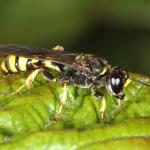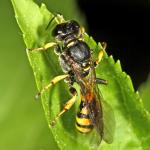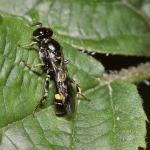Crabro subpunctatus (ROSSI,1790); Crabro sexmaculatus (OLIVIER,1792); Crabro signatus (OLIVIER,1792); Crabro serripes (PANZER,1797); Crabro notatus (ILLIGER,1807); Blepharipus pauperatus (LEPELETIER & BRULLÉ,1835); Crabro armipes (von SEBOLD,1844)
Crossocerus dimidiatus, known under the generic names Crabro, Blepharipus (in error) or Cuphopterus in older works, is one of the larger British Crossocerus with yellow-spotted gasters, resembling Crabro and Ectemnius, rather than the smaller, darker Crossocerus more typical of the British fauna.
C. dimidiatus is found over much of the British Isles, possibly being more common in the north, and is represented in Ireland (where it is equally widespread). The species has a northern distribution in Europe; it is known from the Urals and Kazakhstan, and is found in Japan.
This species is not regarded as being scarce or threatened.
Habitat preferences are unclear but it is likely that any habitat within its range that has suitable prey and nesting sites could potentially hold a population of the species.
Univoltine; May to August (Richards, 1980).
C. dimidiatus preys on snipe-flies, Rhagio species (Diptera: Rhagionidae) in Britain (Richards, 1980). Lomholdt (1975-76) records as prey a variety of dipterous flies of the families, Anthomyiidae, Muscidae, Calliphoridae, Stratiomyidae Syrphidae and Rhagionidae.
The species nests in existing cavities such as burrows in rotten wood or soft mortar between stones or bricks. Peters (1973) suggested that C. dimidiatus exhibited social behaviour comparable with that of the South American primitively eusocial sphecid Microstigmus comes (Matthews, 1968). However, this appears to be speculation on his part, since he was unable to examine the tunnel structure which was in a house wall. It is much more likely that the three females seen were simply sharing a single entrance hole, as has been reported by other workers for C. dimidiatus and other species of Crossocerus (Evans, 1964). Further research is needed to explain this behaviour.
No information available, but specimens have been sighted visiting honeydew on foliage (pers. obs.).
No information available.
2001




